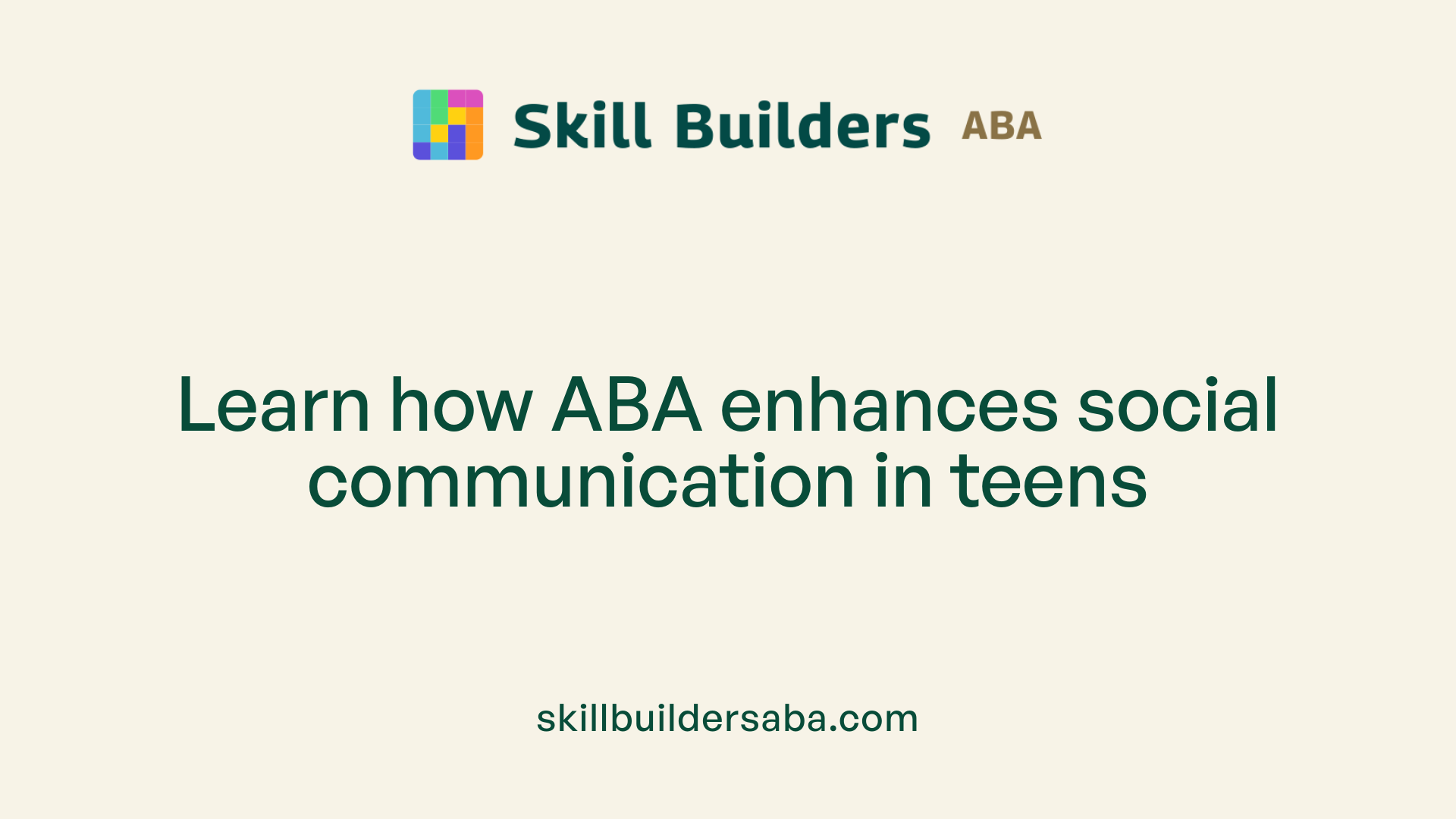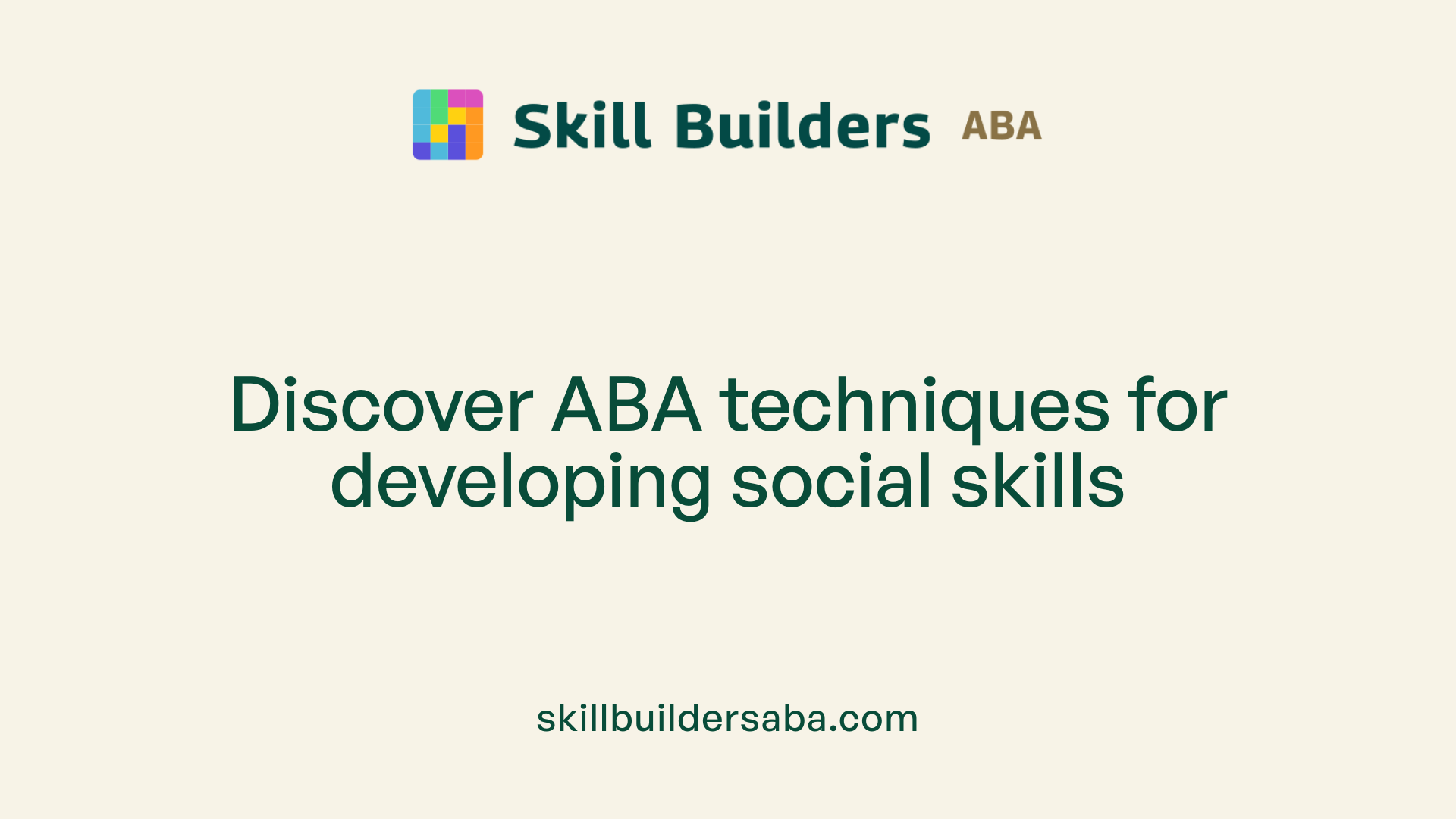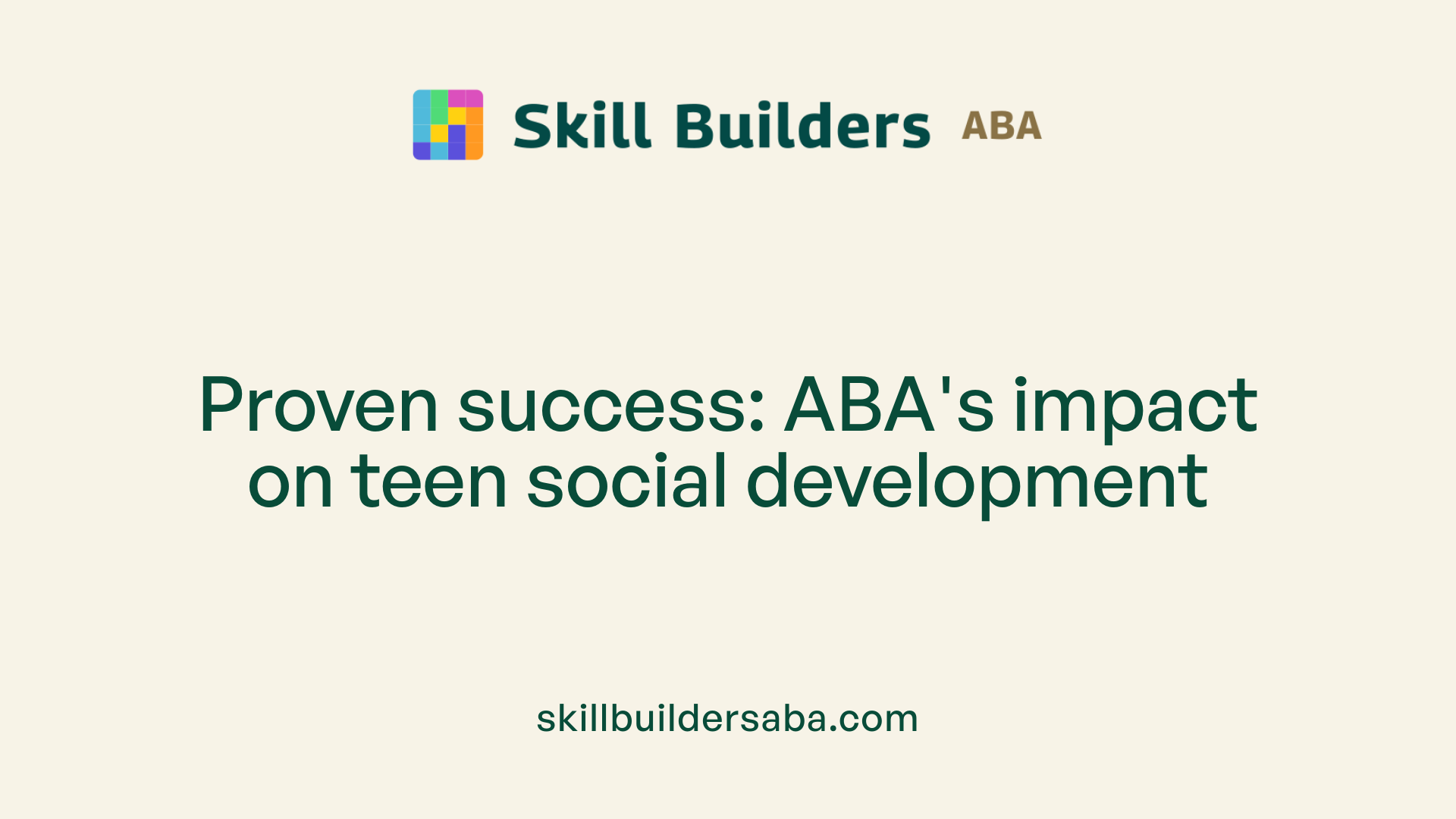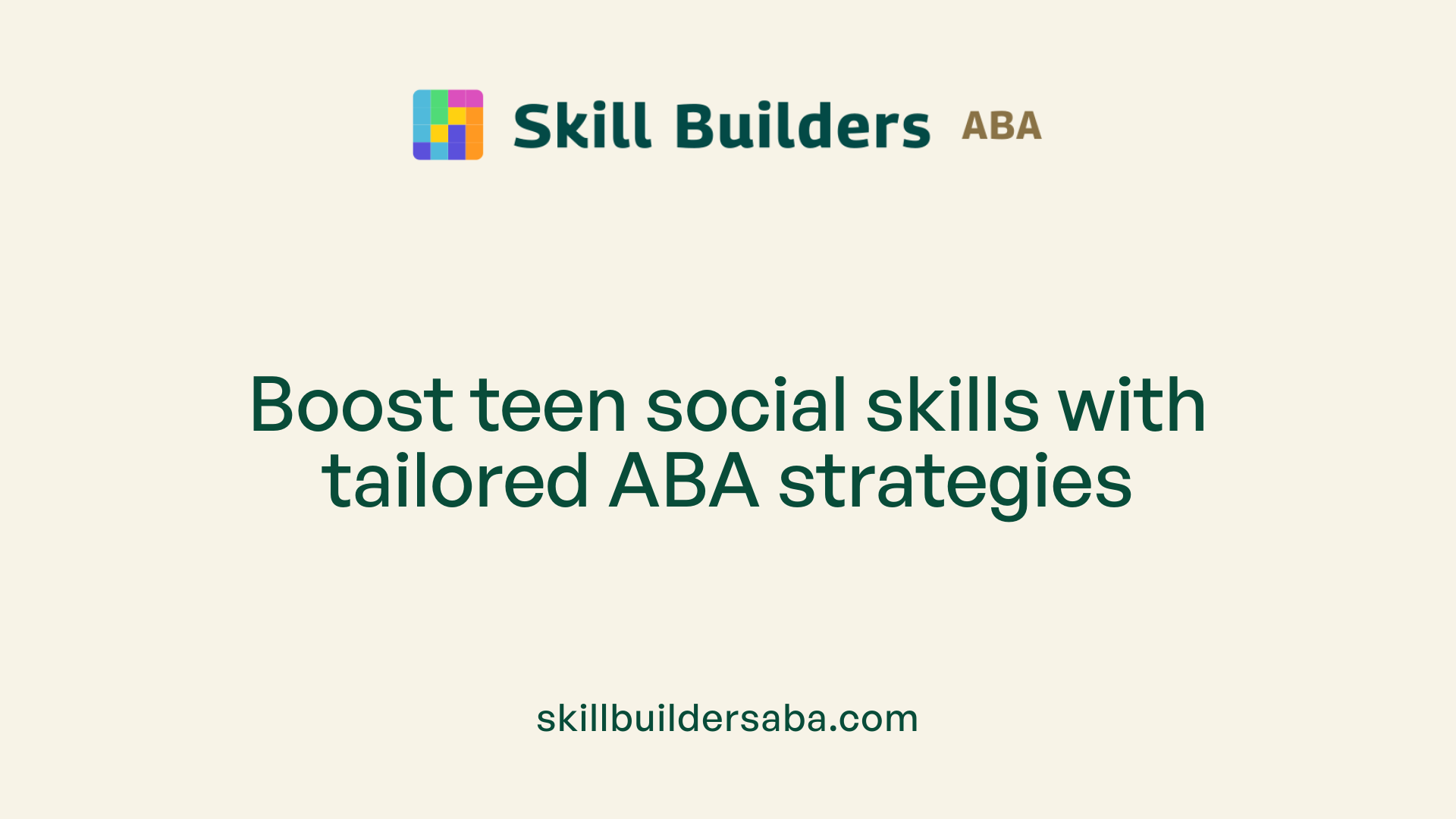
Can ABA therapy help with social skills development in teens
Unlocking Social Potential: The Role of ABA Therapy in Teen Development
Enhancing Social Skills in Adolescents with Evidence-Based Interventions
As teenagers navigate the complex social landscapes of adolescence, many with autism spectrum disorder (ASD) and developmental challenges require targeted support to build meaningful social connections. Applied Behavior Analysis (ABA) has emerged as a leading, scientifically validated approach to fostering social skills. This article explores whether ABA therapy can effectively support social development in teens, detailing the strategies involved, benefits, and applicability across various environments.
Understanding ABA Therapy and Its Focus on Social Skills

Overview of ABA therapy
Applied Behavior Analysis (ABA) therapy is a scientifically supported approach designed to improve socially significant behaviors, particularly in children with autism spectrum disorder (ASD). It uses structured methods like discrete trial training (DTT), natural environment training (NET), and modeling to teach essential skills, including communication and social interaction.
ABA therapy involves individualized plans based on detailed assessments. These plans identify specific social skill deficits and utilize tailored strategies to address them. The therapy emphasizes positive reinforcement, shaping, prompting, and naturalistic teaching to promote meaningful behavioral change.
Purpose of ABA in social skills development
The main goal of ABA therapy is to help children develop better social competence, confidence, and independence. It focuses on enhancing interactions, understanding social cues, and participating in social activities more effectively.
Social skills targeted include greeting others appropriately, maintaining conversations, interpreting facial expressions and body language, taking turns, sharing, and engaging in group play. Activities such as role-playing, social stories, video modeling, and peer-mediated interventions are commonly used.
Through structured practice and reinforcement, children learn to initiate conversations, respond to cues, recognize emotions, and develop friendships. ABA also promotes generalization of these skills outside therapy, encouraging children to apply what they learn in real-life settings like school or community outings.
Studies consistently support ABA's effectiveness in improving communication, social interaction, and adaptive behaviors. Early intervention, parental involvement, and consistent practice significantly enhance positive outcomes.
Is ABA therapy appropriate for teen social skills development?
Yes, ABA therapy is suitable for teens, especially those with ASD. It is adapted to meet the developmental needs of adolescents, helping improve social initiations, conversation skills, emotional regulation, and turn-taking. Treatment plans are individualized and often include real-world community activities.
While much of the research focuses on young children, clinical experience shows that ABA strategies are effective across age groups. For teenagers, therapies emphasize social appropriateness, independence, and functional skills, using positive reinforcement and community-based exercises. Working with experienced ABA professionals ensures interventions are age-appropriate and address specific social challenges faced by teens.
Core Principles and Techniques of ABA for Social Skills
 Applied Behavior Analysis (ABA) is grounded in behavioral modification principles that focus on understanding and changing behavior through systematic interventions. Central to ABA's approach to developing social skills are techniques such as reinforcement, prompting, and shaping, which are tailored to support each child's unique needs.
Applied Behavior Analysis (ABA) is grounded in behavioral modification principles that focus on understanding and changing behavior through systematic interventions. Central to ABA's approach to developing social skills are techniques such as reinforcement, prompting, and shaping, which are tailored to support each child's unique needs.
Reinforcement involves providing positive feedback or rewards to encourage desirable social behaviors, such as sharing, turn-taking, or initiating conversation. Prompting is used to guide children through social interactions, gradually reducing assistance as they become more independent.
Shaping involves breaking down complex social skills into smaller, manageable steps and reinforcing successive approximations towards the targeted behavior. For example, a child may first be rewarded for making eye contact, then for greeting others, and eventually for engaging in reciprocal conversations.
Relevant ABA techniques for social skills development include social stories, which illustrate social situations and appropriate responses, and social scripts that provide predictable dialogue cues. Comic strip conversations further help children understand perspectives and social cues.
Modeling and role-playing offer safe and structured environments where children can observe and practice social interactions. Visual supports such as checklists, schedules, and flowcharts facilitate understanding and help children generalize skills across different settings.
In addition, structured methods like Discrete Trial Training (DTT) and Natural Environment Teaching (NET) are used extensively. DTT helps teach specific skills in a controlled setting, while NET promotes spontaneous social interactions by embedding teaching into everyday activities.
Collaboration with caregivers enables reinforcement and practice of social skills at home and in community settings. Video modeling, priming, and social skills groups are advanced techniques that further promote effective learning.
Overall, these ABA techniques are systematically applied to foster meaningful and lasting improvements in social interaction, communication, and emotional understanding for children with autism.
The Effectiveness of ABA in Improving Teen Social Skills
 Research and evidence strongly support the positive impact of ABA therapy on social skills development in teenagers with autism spectrum disorder (ASD). Numerous studies have demonstrated that structured, evidence-based interventions can lead to meaningful behavioral improvements.
Research and evidence strongly support the positive impact of ABA therapy on social skills development in teenagers with autism spectrum disorder (ASD). Numerous studies have demonstrated that structured, evidence-based interventions can lead to meaningful behavioral improvements.
ABA therapy focuses on targeting specific social behaviors through personalized treatment plans. These plans often include techniques like reinforcement, modeling, role-playing, and social stories, which help teens learn and practice key social skills.
Behavioral improvements seen in teens receiving ABA include better communication, understanding social cues, and engaging in social interactions more confidently. For example, teens learn to initiate conversations, interpret facial expressions and body language, and share in group activities.
Several research studies have measured these outcomes. In general, teens' ability to participate in peer interactions increases, alongside improvements in emotional regulation and social confidence. These advances not only promote social integration but also contribute to overall self-esteem and independence.
A detailed analysis of recent data shows that ABA methods can substantially modify behaviors associated with social skill deficits. With consistent application and individual adaptation, teens often demonstrate greater engagement in social settings such as school, community events, and peer groups.
| Research Focus | Findings | Techniques Used |
|---|---|---|
| Social interaction | Significant increases in peer engagement and conversational skills | Reinforcement, role-playing |
| Communication ability | Improved verbal and non-verbal communicative behaviors | Modeling, social stories |
| Emotional skills | Better regulation and understanding of emotions | Prompting, natural environment training |
| Behavior generalization | Skills transfer to real-life settings | Video modeling, peer-mediated approaches |
Overall, the evidence indicates that high-quality ABA interventions can profoundly enhance social functioning in teens. These improvements support not only better social interactions but also long-term success in academic, personal, and community life.
For further understanding, research evidence on ABA for teens can be explored through scholarly articles and reports, confirming its role as an effective and ethical approach to social skills development.
Benefits of ABA Therapy for Social Interaction Enhancement
What are the benefits of ABA therapy for enhancing social interactions in teens?
ABA therapy offers significant advantages for teens with autism spectrum disorder (ASD), particularly in enhancing their social skills. This evidence-based approach helps teenagers recognize and interpret social cues, including facial expressions, body language, and tone of voice. Such skills are crucial for understanding social contexts and responding appropriately.
Through structured activities like role-playing, modeling, and social stories, teens learn to initiate conversations, take turns, and maintain friendships. The use of positive reinforcement encourages them to practice and reinforce desired social behaviors, contributing to increased confidence in social settings.
Furthermore, ABA therapy emphasizes the generalization of these skills beyond therapy sessions by practicing in real-life environments like school and social outings. This approach not only improves their social competence but also enhances their self-esteem and ability to navigate social interactions effectively.
Involving parents and caregivers in the process helps reinforce skills at home and in community settings. Overall, ABA supports teens in developing meaningful peer relationships, making social interactions more natural and enjoyable, and fostering ongoing social development.
Strategies for Supporting Social Skills Growth in Teens

How can ABA therapy support social skills growth in teens with autism?
ABA (Applied Behavior Analysis) therapy plays a crucial role in helping teens with autism develop and refine social skills. This evidence-based approach tailors interventions to meet each teen’s unique needs, focusing on practical, real-world skills that promote social inclusion.
Through personalized strategies such as role-playing, naturalistic teaching, and video modeling, ABA therapy teaches teens how to initiate and maintain conversations, interpret social cues like facial expressions and body language, and engage effectively with peers. These activities help them understand social norms and respond appropriately in different situations.
Reinforcement techniques are used to encourage desired behaviors, such as sharing, turn-taking, and respectful communication. The therapy emphasizes promoting independence in social interactions while reducing behaviors that may hinder social engagement.
ABA sessions can take place in diverse environments—home, school, or community settings—ensuring that learned skills are transferable and applicable to everyday life. This multi-environment approach boosts the generalization of social skills, making sure teens can use what they learn beyond the therapy sessions.
Overall, ABA fosters improvements in communication, emotional regulation, and social confidence. These skills enable teens with autism to build stronger friendships, participate actively in social activities, and navigate social situations with greater ease. The goal is to enhance their quality of life by increasing their social participation and sense of belonging in their communities.
Developing Social Communication and Emotional Regulation through ABA
How does ABA therapy help develop social communication and emotional regulation in teens?
ABA therapy is a structured, evidence-based approach that can significantly enhance social communication and emotional regulation skills in teenagers with autism and other developmental conditions. It employs personalized interventions designed to teach teens how to interpret and respond to social cues effectively.
Social communication skills include understanding facial expressions, body language, tone of voice, and other non-verbal signals. ABA techniques such as social stories, role-playing, visual supports, and natural environment teaching create real-world scenarios in which teens learn to recognize and use these cues confidently.
For emotional regulation, ABA incorporates strategies like reinforcement of calm behaviors, self-monitoring, and coping skills training. These help teens manage feelings of frustration, anxiety, or anger more effectively.
Parental and caregiver involvement plays a vital role in reinforcing skills outside of therapy sessions. They support generalization of social and emotional skills across different environments and situations.
Overall, ABA's individualized methods foster meaningful progress in teens, improving their ability to communicate, manage emotions, and connect with others more successfully.
Ensuring Generalization and Long-Term Success

How does ABA therapy help develop social skills in teens?
ABA therapy plays a significant role in helping teenagers develop social skills by breaking down complex behaviors into smaller, manageable parts. This approach allows for structured, consistent practice of social interactions across different settings. Techniques such as role-playing, modeling, and social stories are used to prepare teens for real-world situations, including school interactions, community activities, and social gatherings.
A core focus of ABA is the generalization of learned skills. This means that the social behaviors practiced during therapy sessions are encouraged to be used outside the therapy environment. Ensuring skills transfer effectively to everyday life helps teenagers become more confident and independent.
Parental and community involvement are crucial in this process. When parents reinforce social skills at home and in community settings, it increases the likelihood that teens will retain and apply these skills. Consistent reinforcement across multiple environments supports ongoing development and mastery of social behaviors.
By emphasizing practical application and consistency, ABA helps teens internalize important social behaviors such as initiating conversations, understanding social cues, and managing emotions. As a result, adolescents experience increased confidence, better social participation, and greater independence, laying a foundation for successful social navigation throughout their lives.
Fostering Social Growth for the Future
ABA therapy offers a comprehensive, adaptable, and evidence-based approach to improving social skills in teens, particularly those with autism spectrum disorder. Through a variety of tailored strategies—ranging from role-playing and modeling to community-based practice—ABA not only teaches vital social behaviors but also promotes confidence, independence, and stronger peer relationships. The success of ABA depends heavily on individualized treatment plans, active parent and caregiver involvement, and ongoing practice in natural settings. As ongoing research continues to validate its effectiveness, ABA remains a cornerstone of social skills development, helping teens navigate the social complexities of adolescence and beyond.
References
- ABA Therapy for Social Skills Development
- How ABA Therapy Helps Improve Social Skills in Children
- Fostering Meaningful Connections: Social Skills Development
- Social Skills Development ABA Therapy for Kids with Autism
- Enhancing Social Skills Through ABA Therapy
- Can Therapy Help With Social Skills? Supporting Kids and Teens ...
- ABA Therapy for Kids: Helping with Friendships and Social Skills
- How ABA Therapy Helps Improve Social Skills in Children
Clarity for Families Starting Their Journey
Understanding where to begin can feel overwhelming, but you don’t have to figure it out alone. You can learn more about our approach on our site, or if you'd rather talk it through with a coordinator, feel free to get in touch.
Reach Out Today
Learn more about how we can support your child’s growth and development. Contact us to discuss our services and availability in your area.
.svg)